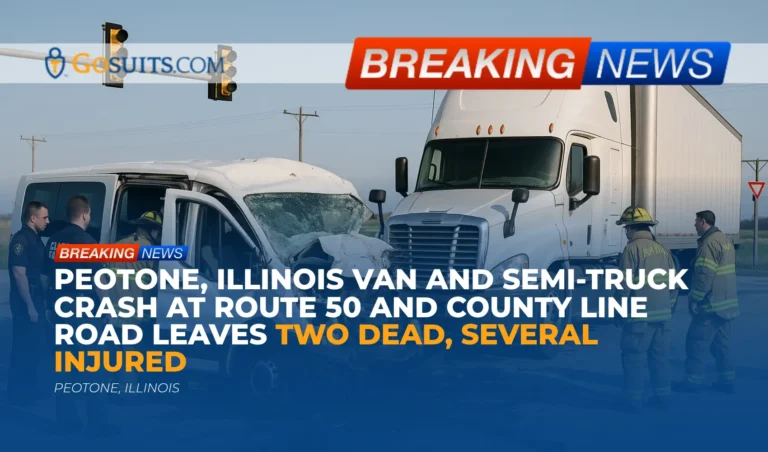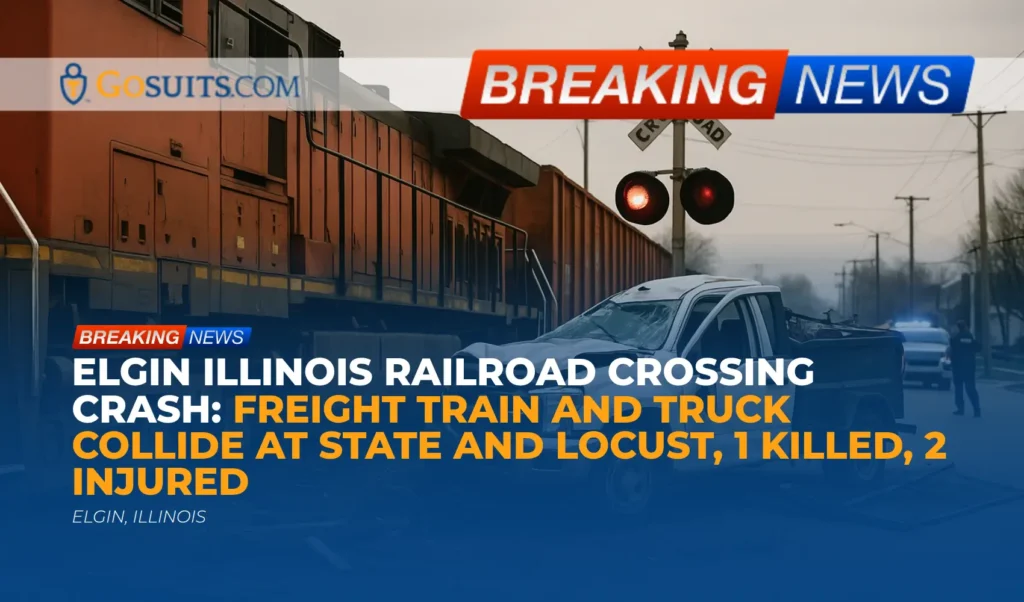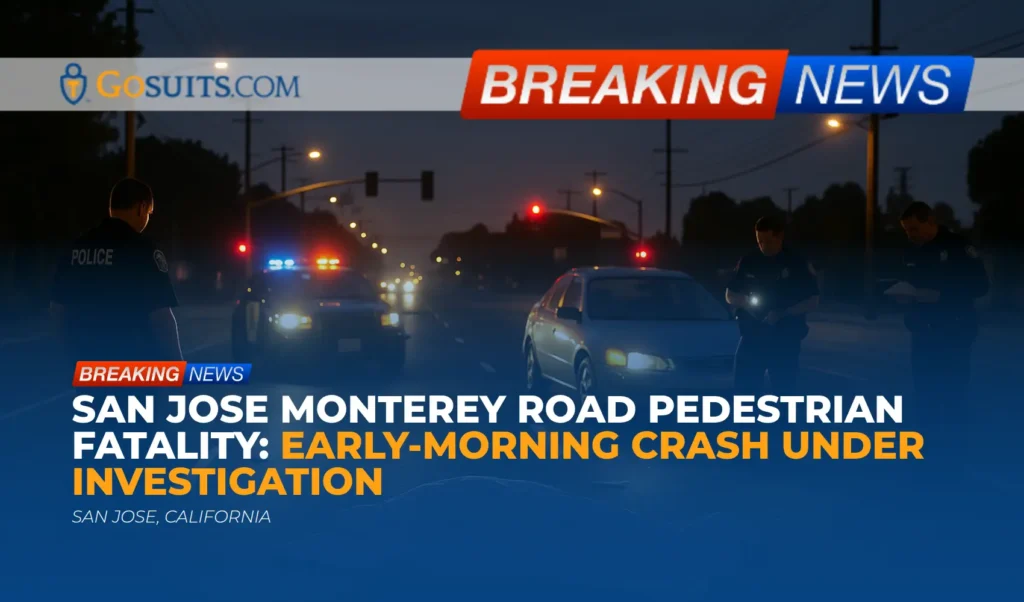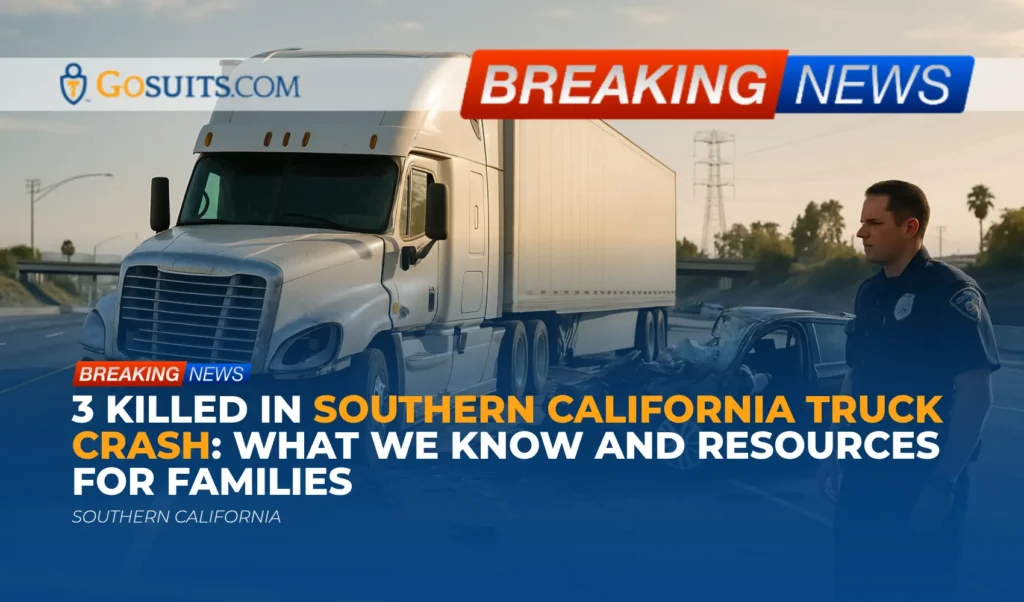- What We Know About the Peotone, Illinois Van and Semi-Truck Collision
- Location and Ongoing Safety Concerns at Route 50 and County Line Road
- Official Agencies Involved and Where to Get Information
- Understanding Potential Civil Liability in a Van vs. Semi Crash
- Rights of Injured Passengers and Families After a Fatal Crash in Illinois
- Key Evidence in Truck and Commercial Vehicle Collisions
- Insurance Considerations and Common Pitfalls
- Steps to Take in the First Days and Weeks
- Support and Resources for Children and Families After Serious Crashes
- Data and Safety Context: Intersections and Large Trucks
- Commentary from Gosuits Peotone, Illinois Personal Injury Attorney
- Why Taking Prompt Action Matters
What We Know About the Peotone, Illinois Van and Semi-Truck Collision
Officials reported a severe two-vehicle collision at approximately 7:35 p.m. on Friday at the intersection of Illinois Route 50 and County Line Road in Peotone, Will County. The crash involved a passenger van and a semi-truck. Emergency responders described heavy damage to both vehicles and significant entrapment within the van. Seven individuals were reportedly trapped and required extrication. Six occupants were transported to area hospitals, with two initially listed in critical condition. One person was pronounced deceased at the scene, and a second critically injured person later died at the hospital. A child was airlifted to Comer Children’s Hospital in Chicago. The Will County Coroner identified one of the deceased as a 35-year-old woman from Aurora who had been a passenger in the van. Illinois State Police assisted on scene, and the cause of the crash remains under investigation.
Manhattan Fire Protection District officials emphasized that this intersection has seen serious incidents before and presents ongoing safety concerns. They noted that they continue to coordinate with legislators and local agencies toward safety improvements at the location.
Location and Ongoing Safety Concerns at Route 50 and County Line Road
Route 50 is a busy corridor carrying local and regional traffic, including commercial vehicles. County Line Road connects rural and semi-rural areas to nearby communities, which can lead to complex traffic patterns at the intersection. The comments from fire officials underscore that this junction has drawn attention due to recurring collisions that strain both motorists and emergency services.
Intersections are among the most hazardous parts of the roadway network. Federal highway safety guidance notes that intersection conflicts, limited sight lines, and turning movements can heighten crash risk, especially where higher speeds or heavy vehicles are involved. National guidance emphasizes proven countermeasures such as improved signalization, altered geometry, enhanced signing and pavement markings, and innovative intersection designs to reduce conflict points. See the Federal Highway Administration’s intersection safety resources for more on why intersections are high-risk and how agencies mitigate danger highways.dot.gov.
Official Agencies Involved and Where to Get Information
After a serious roadway fatality, multiple agencies often handle different parts of the response and follow-up. Families and community members seeking information can consider these channels.
Police crash report and investigation file
Illinois State Police commonly investigate serious and fatal crashes on state routes. A basic crash report, once available, can typically be requested through the Illinois State Police crash reports portal. Availability often depends on when the investigating trooper completes and uploads the report. Learn more at the Illinois State Police crash reports page isp.illinois.gov/CrashReports.
In addition to the basic report, investigative materials such as scene diagrams, photographs, and supplemental narratives may exist. Some items might be withheld while an investigation is ongoing. Portions of these materials can sometimes be requested later under the Illinois Freedom of Information Act (FOIA) from the relevant agency, subject to exemptions. The FOIA statute is at ilga.gov.
Autopsy and coroner information
In Illinois, coroners investigate certain deaths, including those arising from traffic collisions. The coroner determines cause and manner of death and may hold an inquest. Coroner authority and procedures are governed by Illinois law, including provisions of the Counties Code related to coroner duties. Families can typically request death certificates and, in many cases, seek information about autopsy reports through the coroner’s office, following applicable laws and procedures. For the governing framework, see the Illinois Compiled Statutes for coroners within the Counties Code at ilga.gov.
Roadway safety and crash statistics
Statewide crash trends and safety research are available through the Illinois Department of Transportation. IDOT publishes annual crash facts and statistics that can provide context for intersection risks, large truck involvement, and regional patterns. These resources are at idot.illinois.gov.
Understanding Potential Civil Liability in a Van vs. Semi Crash
While the cause of this collision remains under investigation, it is helpful to understand common civil liability pathways in similar incidents. The law typically focuses on whether one or more parties failed to use reasonable care under the circumstances and whether that failure caused injuries or death.
Potentially responsible parties
- Commercial truck driver and motor carrier. If a semi-truck driver was negligent, civil liability may extend to the trucking company under the doctrine of respondeat superior. Company policies, dispatch practices, hours of service, maintenance, and training may also be relevant to the analysis.
- Driver of the passenger van. Passengers generally have claims against any negligent driver, including the driver of the vehicle they were in and drivers of other vehicles involved.
- Vehicle owners and employers. Ownership of the van or involvement of an employer can affect insurance coverage and liability.
- Product manufacturers. In rare cases, a vehicle or component defect contributes to a crash.
- Public entities. If allegations involve roadway design, sight lines, traffic control, or maintenance at a hazardous intersection, claims may involve a public entity. Illinois public entities have unique defenses and deadlines under the Local Governmental and Governmental Employees Tort Immunity Act. See 745 ILCS 10/8-101 for limitations provisions ilga.gov.
These issues are highly fact specific. The investigation record, witness accounts, vehicle data, and physical evidence are essential to evaluating fault and insurance responsibility.
Rights of Injured Passengers and Families After a Fatal Crash in Illinois
Illinois law provides civil remedies to those injured and to families who lose a loved one due to wrongful conduct.

Wrongful death
Illinois’ Wrongful Death Act permits a civil action when a death is caused by another’s wrongful act or neglect. The action is brought for the benefit of the surviving spouse and next of kin, and damages are distributed according to the court’s determination of fair and just compensation in light of the losses suffered. The general filing period is two years from the death, although different timelines can apply in specific contexts, including claims involving public entities. The statute is at 740 ILCS 180 ilga.gov.
Survival claims
Separate from wrongful death, a survival action allows the decedent’s estate to recover damages that the deceased person could have claimed had they survived the incident, such as conscious pain and suffering and certain medical expenses. See 755 ILCS 5/27-6 ilga.gov.
Special considerations with public entities
When a claim implicates a local public entity or employee, limitations periods can be shorter than in other cases. Under 745 ILCS 10/8-101, many actions against local public entities are subject to a one-year limitations period, subject to exceptions. See the statute at ilga.gov. Because timelines vary by claim type and defendant, time is an important factor in preserving rights.
Key Evidence in Truck and Commercial Vehicle Collisions
Evidence preservation is central to understanding what happened and why. In crashes involving larger commercial vehicles, several evidence types commonly matter.
- Electronic logging device and hours of service data. Most interstate commercial carriers use electronic logging devices that record driving time and duty status. Federal rules require drivers to keep records of duty status and require carriers to retain certain records for defined periods. See 49 CFR 395.8 for recordkeeping provisions ecfr.gov.
- Vehicle event data. Many vehicles store speed, braking, throttle, and seatbelt usage data shortly before impact. Downloading and interpreting this data requires prompt action because some systems overwrite information.
- Dash cameras and fleet telematics. Many carriers deploy inward and outward-facing cameras and telematics platforms that can help clarify events and driver behavior. Retention policies vary.
- Maintenance and inspection records. Brake, tire, and lighting conditions are critical when assessing heavy vehicle safety.
- Scene documentation. Skid marks, yaw marks, gouges, debris fields, fluid trails, and final rest positions help reconstruct speed, paths, and impact dynamics.
- Witness statements and 911 audio. Early witness interviews are often more accurate than later recollections. Call audio and CAD logs may be requested from the appropriate agency, often via FOIA under Illinois law at ilga.gov, subject to exemptions and availability.
- Roadway design and control review. Lane configuration, signage, signal timing, crash history, and visibility at the intersection can inform safety analysis and potential policy changes. FHWA highlights proven strategies to reduce intersection crashes highways.dot.gov.
Because some trucking data can be overwritten or lawfully discarded after a limited period, timely preservation letters and coordinated requests are often crucial.
Insurance Considerations and Common Pitfalls
Multiple insurance layers may exist in a van and semi-truck crash. These can include liability coverage for each driver, employer or fleet policies, uninsured or underinsured motorist coverage, and medical payments coverage. Navigating these policies takes careful attention to exclusions, coordination of benefits, and reimbursement provisions.
- Recorded statements. Insurance adjusters often request recorded statements. It is generally prudent to speak with a qualified attorney before providing any recorded or written statement. What is said to an insurer can be used to reduce or deny a claim later.
- Early settlement pressure. Quick offers may not reflect future medical needs, loss of earning capacity, or long-term effects, especially for children or those with complex injuries.
- Commercial carrier tactics. In cases involving large trucks, corporate insurers may rapidly deploy investigators. Documentation gaps or ambiguous statements can be leveraged against claim value.
- Health insurance and liens. Hospital, health plan, or public benefit liens can attach to recoveries. The terms of these liens and the amount that must be repaid depend on applicable law and plan language.
If a claim will be made with an insurance company, it is recommended to contact an attorney first for a free consultation to understand rights and responsibilities. Statements made to insurers without guidance can affect outcomes.
Steps to Take in the First Days and Weeks
The aftermath of a fatal or catastrophic crash is overwhelming. These steps are general information for families and community members seeking to orient themselves.
- Identify the investigating agency and request the basic crash report. For crashes on state routes, the Illinois State Police online portal is the usual starting point: isp.illinois.gov/CrashReports. Have the date, location, and names if known.
- Obtain death certificates and coroner documentation. The local coroner manages cause and manner determinations. Autopsy and inquest information is governed by Illinois law within the Counties Code, including provisions concerning coroner duties and records. See the statutory framework at ilga.gov.
- Gather medical records and billing statements. Keep discharge summaries, imaging, and all bills. For airlifted patients, include flight records.
- Preserve photographs and personal effects. Safeguard photos of the vehicles, the scene, and injuries. Do not repair or dispose of damaged items without first considering their relevance to a potential claim.
- Limit social media. Public posts can be misconstrued by insurers.
- Consider a preservation letter. For commercial vehicle cases, a prompt spoliation notice to the carrier can help preserve ELD, dash-cam, and maintenance data. Federal rules outline recordkeeping expectations for hours of service at 49 CFR 395.8 ecfr.gov.
- Be mindful of deadlines. Illinois wrongful death claims generally carry a two-year period under 740 ILCS 180, while claims against local public entities can have shorter periods such as one year in many instances under 745 ILCS 10/8-101. See ilga.gov and ilga.gov.
Before calling any insurance company to make a claim, consider speaking with an attorney for a free consultation to avoid missteps. What is shared early can carry significant consequences later.
Support and Resources for Children and Families After Serious Crashes
Serious collisions reverberate through families and the broader community. Children and adults may experience intense grief, anxiety, or post-traumatic stress. Local hospitals, schools, and community groups can assist with counseling referrals. The Illinois Department of Public Health provides information on trauma systems and emergency medical services coordination, which can be helpful for understanding the care network that responds in major incidents. See IDPH’s trauma program page at dph.illinois.gov.
Families navigating medical decision making for injured loved ones can keep a shared folder with care team contacts, a running medication list, and a calendar of follow-up appointments. For those grieving a loss, funeral planning, estate paperwork, and benefits questions often arise quickly. The probate court process and estate administration vary based on assets and circumstances, and timing can be important if survival or wrongful death claims are contemplated.
Data and Safety Context: Intersections and Large Trucks
Understanding how and why these crashes happen can inform both personal choices and public policy.
- Intersections remain a high-risk environment. The Federal Highway Administration highlights that a significant share of serious traffic injuries and fatalities occur at or are related to intersections, where multiple conflict points exist and human errors can quickly lead to severe outcomes. FHWA outlines strategies such as improved signal phasing, protected turn lanes, and innovative designs to reduce such conflicts highways.dot.gov.
- Large trucks and crash severity. Because of their mass, crashes involving large trucks can create disproportionately severe injuries for occupants of other vehicles. The National Highway Traffic Safety Administration provides national summaries and fact sheets on large truck safety and crash involvement at nhtsa.gov.
- Illinois crash trends. State-level Crash Facts and Statistics from IDOT offer annual snapshots of fatalities, serious injuries, and contributing factors across roadway types, including intersections. Reviewing recent years of data can help communities prioritize safety investments. IDOT’s resources are at idot.illinois.gov.
Public agencies often review severe crashes for lessons learned, and residents, advocates, and local leaders play an important role in advancing roadway improvements that prevent future harm.

Commentary from Gosuits Peotone, Illinois Personal Injury Attorney
We extend heartfelt condolences to the family and friends of those who lost their lives, and we offer our concern for everyone who was injured in this devastating collision. This article is shared for educational purposes and general information to help the community understand what steps may follow and what rights may be implicated.
Based on the initial reports, this was a high-energy impact at a known trouble spot where a passenger van and a semi-truck collided. When a crash involves a commercial vehicle, the scope of the civil investigation often widens beyond driver behavior alone. It can include dispatch practices, hours of service compliance, maintenance, and whether roadway conditions or intersection controls contributed. Early preservation of evidence is vital in these circumstances.
Insurance companies and large corporate carriers typically move quickly after an incident. They may obtain statements, collect documents, and frame the narrative in ways that limit exposure. People without guidance often feel pressured to provide recorded statements or to accept early offers that do not account for long-term needs, future medical procedures, or the impact on children and dependents. Insurers also rely on technical policy terms that can be hard to parse, including exclusions and reimbursement rights that can erode a settlement if not addressed carefully.
Obtaining a free consultation with a seasoned and skilled attorney before speaking with any insurer can be an important safeguard. A consultation can clarify what coverages may apply, who the potential defendants are, what evidence should be preserved immediately, and how time limits might affect the case, especially if a public entity could be involved. What someone says to an insurance company can be used against them later, so pausing to get clear guidance can make a measurable difference.
Why Taking Prompt Action Matters
The following points explain why timely steps are important after a serious crash and what actions generally make sense in the near term. This is shared to help the community understand urgency and context.
- Secure official records early. Ordering the basic crash report from the investigating agency provides a foundation for insurance claims and medical coordination. Delay can slow benefits and reduce clarity when memories fade.
- Preserve time-sensitive evidence. Commercial vehicle electronic logging, camera footage, and telematics may be overwritten or purged under routine retention schedules. Prompt preservation requests help ensure crucial data is not lost. Federal rules describe duty status recordkeeping at 49 CFR 395.8 ecfr.gov.
- Understand deadlines. Illinois law sets specific time limits. Wrongful death actions generally have a two-year period under 740 ILCS 180, while many claims against local public entities are one year under 745 ILCS 10/8-101. Acting promptly avoids missing opportunities to investigate, negotiate, or file within those periods. See ilga.gov and ilga.gov.
- Coordinate medical care and documentation. In the first weeks, keeping a complete medical record helps ensure insurers evaluate the full scope of injury. Thorough documentation also supports future care planning.
- Use caution with insurance communications. Recorded statements and broad authorizations can affect claim value. Consulting with counsel first can help avoid inadvertent missteps that are hard to undo later.
- Engage with roadway safety efforts. Community feedback to agencies can accelerate intersection improvements that prevent future tragedies. Resources on intersection safety and proven countermeasures are available from FHWA at highways.dot.gov.
Taking these steps promptly can help protect legal rights, preserve essential information, and contribute to a clearer understanding of what happened and what support may be available.






